West End Workbench
Moderators: 52D, Tom F, Rlangham, Atlantic 3279, Blink Bonny, Saint Johnstoun, richard
-
jwealleans
- LNER A4 4-6-2 'Streak'
- Posts: 4303
- Joined: Wed Oct 25, 2006 8:46 am
-
karlrestall
- NBR D34 4-4-0 'Glen'
- Posts: 252
- Joined: Sat Mar 18, 2006 2:10 pm
- Location: Teesside (51K)
-
rob
- GCR D11 4-4-0 'Improved Director'
- Posts: 435
- Joined: Sat Mar 11, 2006 1:19 pm
- Location: Cork Ireland
These are top notch Jonathan,no way I'll ever get handrails etc like that on a Kirk,and the underframe detail is really effective.A very minor enqury-I have a good few Kirks to upgrade-what do you use in material and size for the corridor handrails?I find it the most irritating job,and I gather they were not brass as I originally assumed but polished iron or similar?
-
jwealleans
- LNER A4 4-6-2 'Streak'
- Posts: 4303
- Joined: Wed Oct 25, 2006 8:46 am
Hi Rob,
For the internal handrails I use .5 mm brass wire. I have a suitably sized piece of plastikard which sits on the floor of the coach and then I put a blob of clearfix on each end of the wire (and in the middle if it's over multiple windows) then stick it on, resting on the plastikard to get it level and at the right height. I don't find it a great hardship and it sticks out like a sore thumb if they aren't there.
Michael Harris says they were brass except in catering vehicles and some first-class coaches where they were chrome.
The external handrails are MJT and are all etched up - they're really a doddle to put on as long as you remember to carve the moulded handles off before you paint. I think they make a great difference. The guard's compartment ones should be black - they were steel rather than brass.
For the internal handrails I use .5 mm brass wire. I have a suitably sized piece of plastikard which sits on the floor of the coach and then I put a blob of clearfix on each end of the wire (and in the middle if it's over multiple windows) then stick it on, resting on the plastikard to get it level and at the right height. I don't find it a great hardship and it sticks out like a sore thumb if they aren't there.
Michael Harris says they were brass except in catering vehicles and some first-class coaches where they were chrome.
The external handrails are MJT and are all etched up - they're really a doddle to put on as long as you remember to carve the moulded handles off before you paint. I think they make a great difference. The guard's compartment ones should be black - they were steel rather than brass.
-
jwealleans
- LNER A4 4-6-2 'Streak'
- Posts: 4303
- Joined: Wed Oct 25, 2006 8:46 am
Hi John,
The ducket is the small protrusion on the end of the brake van section which allowed the guard to see fore and aft along the train without sticking his head out of the window. You'll note that it's only present on one side. The other brake I am building (D. 42) didn't have them at all and they were gradually dispensed with under the Big Four.
The alarm gear is what makes the communication cord act on the brakes and is at the end of the roof on the corridor end. I don't know in detail how it works but it both applies the brakes and displays a little tell-tale such that the crew can tell in which coach the cord was pulled.
The ducket is the small protrusion on the end of the brake van section which allowed the guard to see fore and aft along the train without sticking his head out of the window. You'll note that it's only present on one side. The other brake I am building (D. 42) didn't have them at all and they were gradually dispensed with under the Big Four.
The alarm gear is what makes the communication cord act on the brakes and is at the end of the roof on the corridor end. I don't know in detail how it works but it both applies the brakes and displays a little tell-tale such that the crew can tell in which coach the cord was pulled.
-
karlrestall
- NBR D34 4-4-0 'Glen'
- Posts: 252
- Joined: Sat Mar 18, 2006 2:10 pm
- Location: Teesside (51K)
Thats in theory anyway. To actually see any portion of the train out of it you have to lean right back in the seat, it is usually quicker and easier to stick your head out of the window.jwealleans wrote:The ducket is the small protrusion on the end of the brake van section which allowed the guard to see fore and aft along the train without sticking his head out of the window.
Regards
Karl
NYMR Guard
-
jwealleans
- LNER A4 4-6-2 'Streak'
- Posts: 4303
- Joined: Wed Oct 25, 2006 8:46 am
The end is finally in sight for the Gresleys - they can now cure for a couple of weeks before weathering, corridor connectors and final troubleshooting. I had some running problems with them on the club layout (chosen because the track is like a rough sea) but we are gradually working through these.
This is the completed 4 set which was the original project:

From front to rear:
Brake 3rd to D41

.. and one of those cruel closeups which shows how hard it is to mask that beading successfully. It does show what a difference the MJT grab and T handles make to these coaches - well worth the effort.
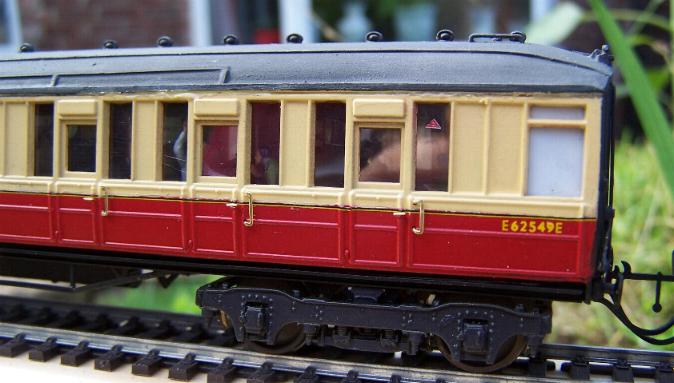
CK to D9 - one of the 'cut and shut' jobs in the rake:

TK to D141 - this is as near the straight Kirk kit as I get:

BTK to D146:

.. and this is the only difference, the ducket. Again those lovely MJT handles make all the difference and save a very fiddly soldering job.

This is the odd man out - I did two of the Composites in case I screwed one up but they both came out quite well. The intention is to weather this one more heavily and add it as a strengthener, or use it in a separate rake.
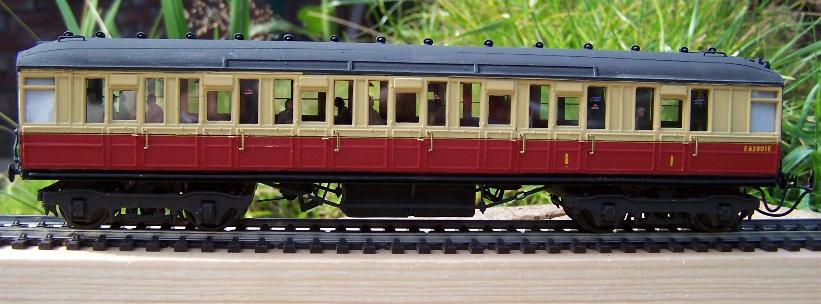
The interior is visible but you have to get pretty close to see it. You can also see where I made the holes for the commode handles in the wrong place. The window signs are John Peck's (Precision Labels)
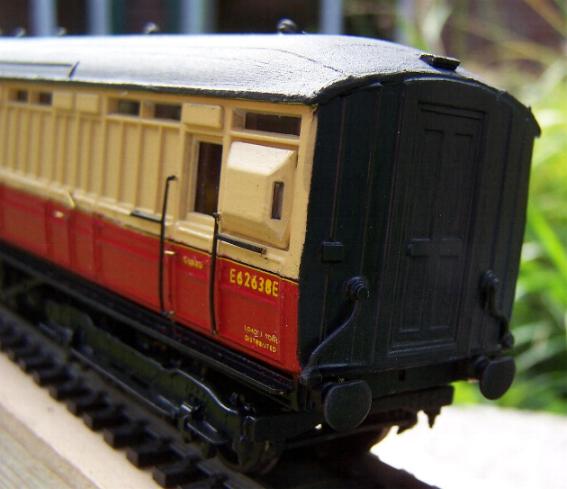
This is the completed 4 set which was the original project:

From front to rear:
Brake 3rd to D41

.. and one of those cruel closeups which shows how hard it is to mask that beading successfully. It does show what a difference the MJT grab and T handles make to these coaches - well worth the effort.

CK to D9 - one of the 'cut and shut' jobs in the rake:

TK to D141 - this is as near the straight Kirk kit as I get:

BTK to D146:

.. and this is the only difference, the ducket. Again those lovely MJT handles make all the difference and save a very fiddly soldering job.

This is the odd man out - I did two of the Composites in case I screwed one up but they both came out quite well. The intention is to weather this one more heavily and add it as a strengthener, or use it in a separate rake.

The interior is visible but you have to get pretty close to see it. You can also see where I made the holes for the commode handles in the wrong place. The window signs are John Peck's (Precision Labels)

Last edited by jwealleans on Tue Oct 02, 2018 11:42 am, edited 7 times in total.
-
karlrestall
- NBR D34 4-4-0 'Glen'
- Posts: 252
- Joined: Sat Mar 18, 2006 2:10 pm
- Location: Teesside (51K)
-
jwealleans
- LNER A4 4-6-2 'Streak'
- Posts: 4303
- Joined: Wed Oct 25, 2006 8:46 am
-
jwealleans
- LNER A4 4-6-2 'Streak'
- Posts: 4303
- Joined: Wed Oct 25, 2006 8:46 am
-
jwealleans
- LNER A4 4-6-2 'Streak'
- Posts: 4303
- Joined: Wed Oct 25, 2006 8:46 am
A bit of a recap, actually, since I don't seem to have posted much recently.
To pick up on the theme above, here are some card corridor connectors which I made up from card. They fold up and slot into each other and are very quick to put together. We'll see how they hold up under exhibition conditions this weekend.
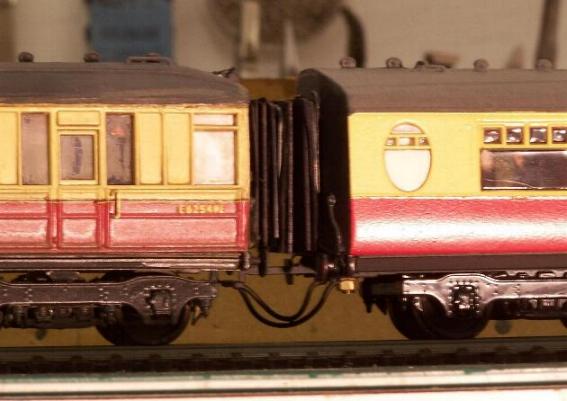
I built these up a couple of weekends ago after I decided that the mess of shoeboxes, bubblewrap and string which holds most of my exhibition stock had to go. The stripwood cost me £2.50, the hardboard bases were recycled from some internal doors (anyone remember Barry Bucknell?) and it took me a morning to put them together.
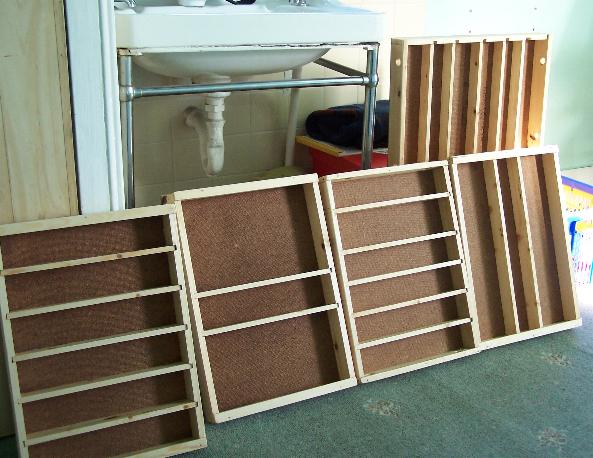
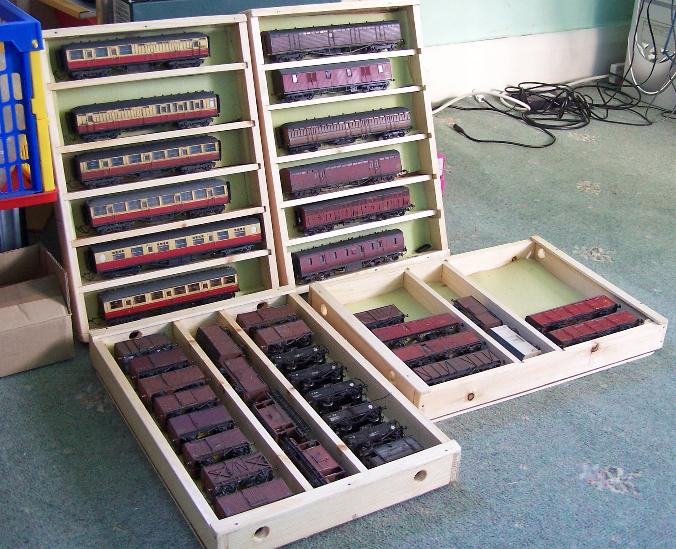
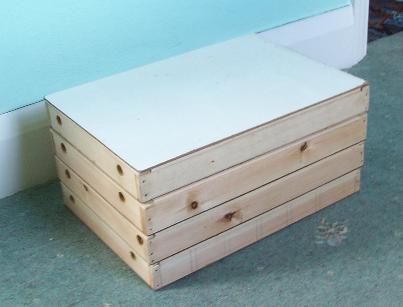
Other jobs have involved making 'converter' vehicles for the Bill Bedford couplings I've adopted for my corridor stock. This Parkside LMS CCT needed to be compensated in order to run at the head of a heavy rake. Note the screw link at one end and the hole for the pin from the BB coupling at the other.
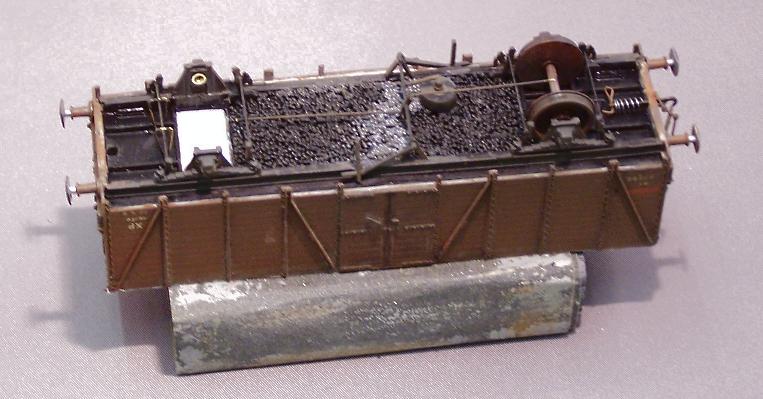
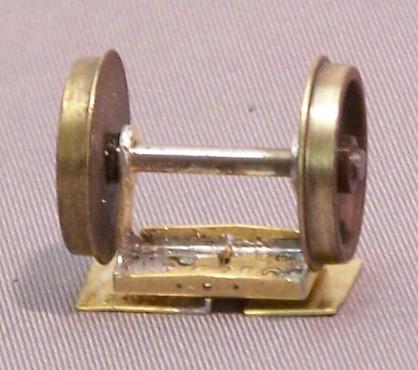
I used one of the MJT units for RTR trucks. It fits quite well. The hole in the floor was required because the unit is designed for 12mm wheels and these are 14.
The other one I've made up is a straightforward Parkside corrugated end van. This is weighted and compensated and has my usual extra brake gear detailing but is otherwise as supplied:
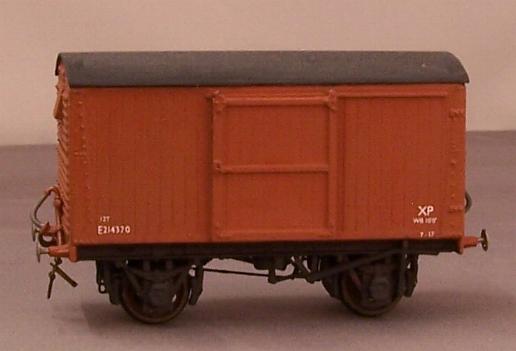
Also complete and ready for Hull is this Gresley BG. I didn't fancy just doing a straight build, so this is an ex-ECJS underframe recycled to a 56' van. It's just slightly out of the ordinary.

In between these I started restoring a pair of D & S kits I picked up a long time ago at a swapmeet having been quite badly botched. I was able to find instructions for this LDEC horsebox:
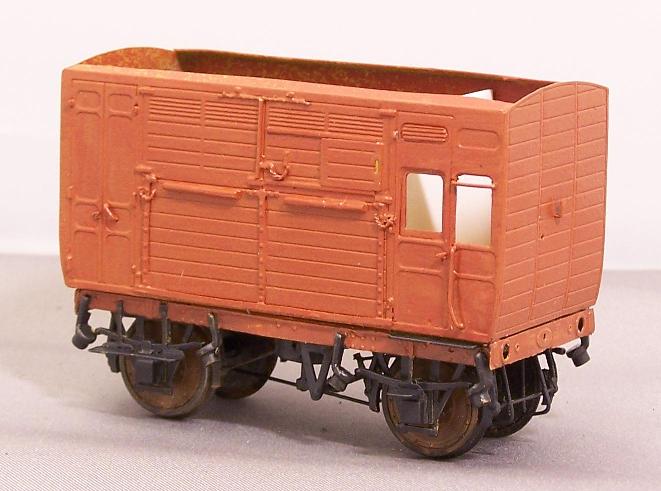
and had to use a drawing (Historic Carriage Drawings Vol. 3) for this Great Eastern SCV.
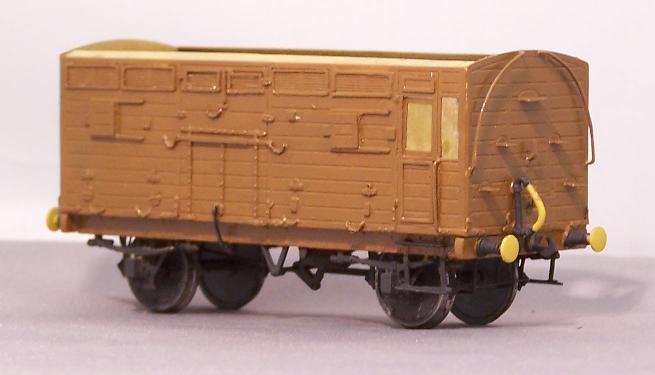
These are approaching completion but I will have to have some transfers made up in order to finish them. This is how they presently stand:
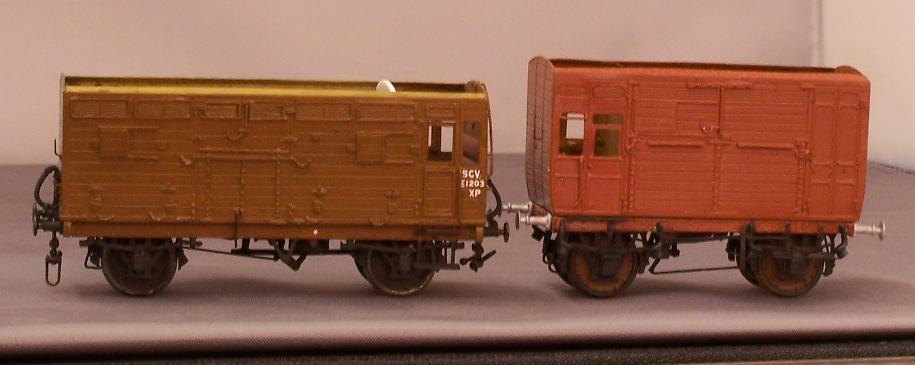
If anyone is going to Hull show this weekend please come over to Thurston and say hello.
To pick up on the theme above, here are some card corridor connectors which I made up from card. They fold up and slot into each other and are very quick to put together. We'll see how they hold up under exhibition conditions this weekend.

I built these up a couple of weekends ago after I decided that the mess of shoeboxes, bubblewrap and string which holds most of my exhibition stock had to go. The stripwood cost me £2.50, the hardboard bases were recycled from some internal doors (anyone remember Barry Bucknell?) and it took me a morning to put them together.



Other jobs have involved making 'converter' vehicles for the Bill Bedford couplings I've adopted for my corridor stock. This Parkside LMS CCT needed to be compensated in order to run at the head of a heavy rake. Note the screw link at one end and the hole for the pin from the BB coupling at the other.


I used one of the MJT units for RTR trucks. It fits quite well. The hole in the floor was required because the unit is designed for 12mm wheels and these are 14.
The other one I've made up is a straightforward Parkside corrugated end van. This is weighted and compensated and has my usual extra brake gear detailing but is otherwise as supplied:

Also complete and ready for Hull is this Gresley BG. I didn't fancy just doing a straight build, so this is an ex-ECJS underframe recycled to a 56' van. It's just slightly out of the ordinary.

In between these I started restoring a pair of D & S kits I picked up a long time ago at a swapmeet having been quite badly botched. I was able to find instructions for this LDEC horsebox:

and had to use a drawing (Historic Carriage Drawings Vol. 3) for this Great Eastern SCV.

These are approaching completion but I will have to have some transfers made up in order to finish them. This is how they presently stand:

If anyone is going to Hull show this weekend please come over to Thurston and say hello.
Last edited by jwealleans on Wed Oct 03, 2018 2:38 pm, edited 4 times in total.
-
jwealleans
- LNER A4 4-6-2 'Streak'
- Posts: 4303
- Joined: Wed Oct 25, 2006 8:46 am
I started this after the weekend because a small parcel had arrived. It was one of the first kits I built (badly) when I came back to modelling in the late 90s. Here it is with paint, roof and glazing removed, handrails replaced with wire and in primer:
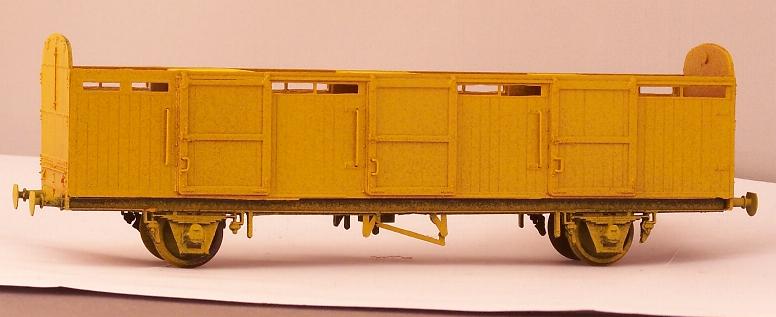
Here I've detailed the roof and painted the bodywork teak brown:

Now the parcel: I had commissioned some transfers from John Peck and wanted to see how they looked.
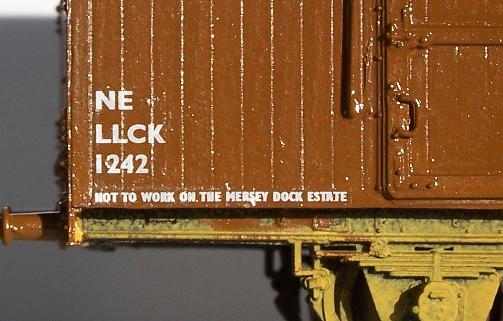
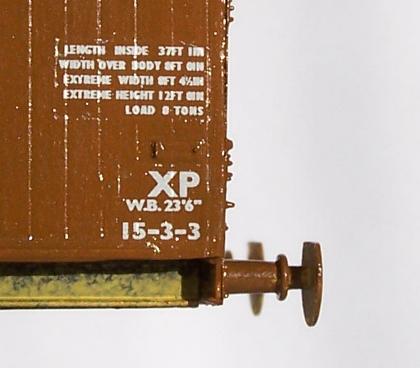
I'm very pleased with them. See my post in Classifieds if you want some.

Here I've detailed the roof and painted the bodywork teak brown:

Now the parcel: I had commissioned some transfers from John Peck and wanted to see how they looked.


I'm very pleased with them. See my post in Classifieds if you want some.
Last edited by jwealleans on Wed Oct 03, 2018 2:38 pm, edited 3 times in total.